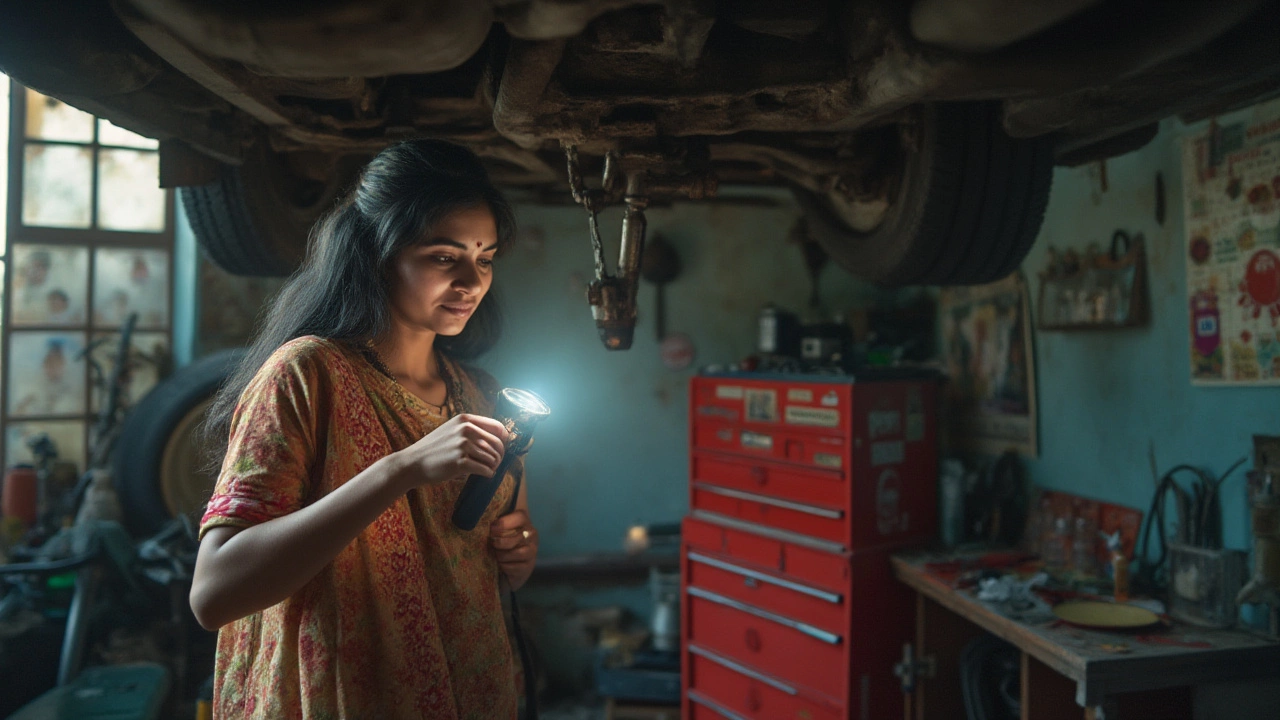
Ever hit a pothole and felt the car never quite drove right again? You're not just being picky. Even the smallest knock can mess with your suspension, often with sneaky, slow-building effects. Miss it, and you're risking uneven tyre wear, expensive repairs down the road, and a car that just doesn't feel safe. The tricky part? Suspension components hide underneath, mostly out of sight—so issues can go unnoticed until they grow into major headaches.
Understanding Suspension and Why Bent Components Matter
Your suspension isn’t just there to soak up bumps for comfort. It’s the backbone of your car’s control. When any part—like a control arm, strut, or spindle—gets bent, the geometry changes. That throws off the angle of the wheels, known as camber, caster, and toe. Even a couple of degrees can make a massive difference. According to the Institute of Advanced Motorists, improper suspension alignment after an impact can shorten tyre life by as much as 50%. That’s not only bad for your wallet, but also for your grip on the road—especially on those wet Bristol cobbles.
Most modern cars use independent suspension systems, with each wheel attached to the car through arms, bushings, and joints. When you smack a kerb or hit a deep pothole, those metal arms can bend, sometimes looking no different at first glance. But internally, that distortion means the wheel is no longer positioned exactly as the manufacturer intended. Some common casualties include lower control arms, struts, and trailing arms. SUVs and pickups take a beating off the tarmac as well, though they often hide tougher components underneath. Yet, no vehicle is immune.
The real kicker? Sometimes, the damage only becomes noticeable during a routine MOT, or when symptoms like wobbly steering or rapid tyre wear appear. By then, the problem may have spread to other parts. And with technologies like adaptive dampers and sensor-laden suspension systems in high-end cars, a bent bit of metal can quickly trip diagnostic codes, too. Bottom line: bent suspension isn’t just a cosmetic issue—it’s a safety one.
| Component | How It Gets Bent | Symptoms |
|---|---|---|
| Control Arm | Hitting kerbs, potholes | Poor alignment, uneven tyre wear |
| Strut | High-impact bumps, accidents | Leaning, rattling, odd steering |
| Trailing Arm | Off-roading, major roadworks | Pulling to one side, odd noises |
| Spindle/Knuckle | Severe impact, collisions | Wobble, inconsistent braking |

Signs Your Suspension Might Be Bent
So, what should you actually look for? Start with your tyres. If you spot uneven wear—especially if the inside or outside tread looks scrubbed down—your alignment could be out, or worse, you've got a bent component. Another red flag is a steering wheel that’s no longer centered as you drive straight. Feel a pull to one side, or is your car suddenly working harder just to go in a straight line? Those are all hints.
Here are practical signs and symptoms to check for:
- Bent suspension shows up first as changes in the car’s handling. If it suddenly feels floaty, bounces excessively, or crashes over bumps differently left to right, listen to your gut. Trust how your car feels before trusting your eyes.
- Noticeable clunks, rattles, or squeaks, especially when turning or braking, suggest metal-on-metal contact or a stressed joint. That’s never supposed to happen if everything’s straight.
- Does your car lean to one side? Take a look at the car on level ground. Get low and eyeball the wheel arch gaps above each tyre—sometimes one sits lower, which hints at a bent strut or spring.
- Vibrations or shudders through the steering wheel, particularly under braking or at motorway speeds, often point to something amiss below. Not always, but it’s a clue worth following.
- After a serious impact, wheel alignment may be uncorrectable by standard adjustments. If your alignment shop can’t get the numbers right, chances are something is bent that shouldn't be.
It’s not just about visual checks either. I once had a client in Bristol who swore his car was fine after mounting a kerb—until he noticed cars behind him flashing their lights. Turns out, his rear wheel had developed so much negative camber you could see it from two cars back. Another time, after a heavy pothole hit, I spotted uneven suspension by measuring wheel-to-arch heights with a simple measuring tape—a cheap and easy home trick if you’re suspicious.
You might not have a car lift at home, but there’s still loads you can do. Check by jacking up one wheel and wiggling it firmly with your hands at the 12 and 6 o'clock positions (for vertical movement). Feel slop or hear a click? That means worn or bent parts. Do the same at 3 and 9 o'clock—they check for horizontal play. Don’t forget to check both sides for differences.

How to Properly Diagnose and Confirm Bent Suspension
Not all suspension issues are visible to the naked eye, especially if the bend is minor or internal. Getting things properly diagnosed is key. Here’s how you can go about it—from driveway detective work to asking the right questions at the garage.
First, let’s list some at-home steps to pick up on possible damage:
- Look straight on at your tyres: Does one tyre look angled inwards or outwards compared to the other?
- Roll your car onto flat ground and step back to compare wheel arch gaps.
- Measure the distance from the ground to the arch at each wheel—write down results. Small differences (2-3mm) are normal; anything over 10mm is suspicious.
- While parked, turn the steering sharply side to side to see if the tyres scrub or catch any part of the bodywork, which suggests poor alignment or a bent arm.
- After driving, put your hand on each wheel: Uneven temperatures can mean extra drag due to misalignment.
If your DIY detective work makes you suspicious, it’s time for the pros. Most modern alignment shops in the UK use laser or digital systems—these can detect alignment angles to within tenths of a degree. If they tell you they can’t get the readings into spec, ask them to check for bent arms or struts. A decent mechanic will spot tell-tale kinks, crumples, or stretched bushings—things that just don’t sit right even if they’re not totally snapped.
Here’s a quick reference table for what specialists look for with alignment readings:
| Alignment Angle | Normal Range | Indicates Bent If... |
|---|---|---|
| Camber | -1° to +1° | >+/-2°, uneven side to side |
| Caster | +2° to +7° | Differ more than 1.5° between sides |
| Toe | 0° to +0.25° | Impossible to adjust within spec |
On some cars, manufacturers publish measurement specs for the suspension arms themselves, down to the millimetre. A bent arm may only be out by 5mm compared to a new one, but that’s enough to cause chaos on the road. If you’re feeling brave, you can even lay a straight edge or builder’s spirit level along visible components. Any gap or bump that isn’t mirrored on the other side is a warning sign.
Tech tools like dial gauges can check strut or arm runout if you can get the part off the car, but most folks will want to leave this to a professional. The important bit? Don’t settle for just a new alignment if the readings are stubborn. A well-aligned car that’s hiding a bent piece will just wander and destroy tyres all over again. Get bent parts replaced, not just “adjusted”.
In the end, trusting your instincts, being observant, and pushing for a thorough check at the garage can save a small fortune—both in cash and safety. Don’t let squeaks, odd wobbles, or a twitchy steering wheel slide because life’s busy. A straight and healthy suspension is your invisible guardian, especially on the rain-soaked, twisty lanes around Bristol. Stay sharp, and you’ll catch any bend before it bends your car—or your wallet—out of shape.



